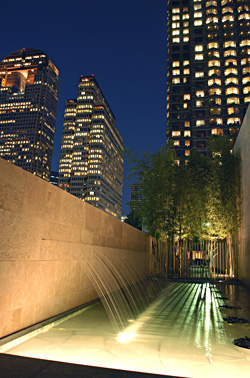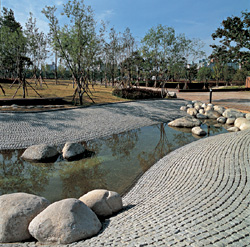DEFINING THE PROFESSION
A Profession In Demand
 From city council rooms to corporate boardrooms, there is increasing demand today for the professional services of landscape architects. This trend reflects the public’s desire for better housing, recreational and commercial facilities, and its expanded concern for environmental protection. Residential and commercial real estate developers, federal and state agencies, city planning commissions, and individual property owners are all among the thousands of people and organizations in America and Canada that will retain the services of a landscape architect this year.
From city council rooms to corporate boardrooms, there is increasing demand today for the professional services of landscape architects. This trend reflects the public’s desire for better housing, recreational and commercial facilities, and its expanded concern for environmental protection. Residential and commercial real estate developers, federal and state agencies, city planning commissions, and individual property owners are all among the thousands of people and organizations in America and Canada that will retain the services of a landscape architect this year.
More than any of the other major environmental design professions, landscape architecture is a profession on the move. It is comprehensive by definition-no less than the art and science of analysis, planning design, management, preservation and rehabilitation of the land.
In providing well-managed design and development plans, landscape architects offer an essential array of services and expertise that reduces costs and adds long-term value to a project.
Clear differences do exists between landscape architecture and the other design professions. Architects primarily design buildings and structures with specific uses, such as homes, offices, schools and factories. Civil engineers apply scientific principles to the design of city infrastructure such as roads, bridges, and public utilities. Urban planners develop a broad overview of development for entire cities and regions.
Landscape architects touch on all the above mentioned design professions, integrating elements from each of them. While having a working knowledge of architecture, civil engineering and urban planning, landscape architects take elements from each of these fields to design aesthetic and practical relationships with the land.
A Diverse Profession
Landscape architecture is one of the most diversified of the design professions.
Landscape architects design the built environment of neighborhoods, towns and cities while also protecting and managing the natural environment, from its forests and fields to rivers and coasts. Members of the profession have a special commitment to improving the quality of life through the best design of places for people and other living things.
In fact, the work of landscape architects surrounds us. Members of the profession are involved in the planning of such sites as office plazas, public squares and thoroughfares. The attractiveness of parks, highways, housing developments, urban plazas, zoos and campuses reflects the skill of landscape architects in planning and designing the construction of useful and pleasing projects.
From coast to coast, in every region of the world, examples of the landscape architecture profession can be found. Many landscape architects are involved in small projects, such as developing plans for a new city park or site plans for an office building, other members of the profession have contributed their expertise to numerous projects which include:
Preservation of Yosemite Park and Niagara Falls
Management plan for the Alaskan Maritime National Wildlife Refuge
Design of the U.S. Capitol Grounds
Design of Mount Royal Park in Montreal, Quebec
Development of Stanford University site
Creation of Boston’s “emerald necklace” of green spaces tying the city to the suburbs
Plans for Baltimore’s park system and Inner Harbor area
Design of “new towns” such as Columbia, Maryland, and Reston, Virginia
Landfill reclamation for Fresh Kills in New York and Dyer in Florida
Plans for Golden Gate National Recreation Area in San Francisco, California
Sursum Cordan Affordable Housing, Washington, D.C.
Design for water treatment and park facility in Hillsboro, Oregon
Master plan for King Saud University in Saudi Arabia
Restoration of the landscape along the Baltimore-Washington Parkway in Maryland
Depending on the scope of the project for clients, ranging from a local developer to the federal government, landscape architects may plan the entire arrangement of a site, including the location of buildings, grading, stormwater management, construction and planting. They may also coordinate teams of design, construction and contracting professionals.
Already, federal and state government agencies ranging from the National Park Service to local park planning boards employ a large number of landscape architects. More and more private developers realize that the services of a landscape architect are an integral part of a successful, more profitable project.
The Profession in Practice
Landscape architecture in the 21st Century cannot be described in a few simple terms. The scope of the profession is too broad and the projects too varied.
 A variety of often interwoven specializations exist within the profession, including the following: Landscape Design, the historical core of the profession, is concerned with detailed outdoor space design for residential, commercial, industrial, institutional, and public spaces. It involves the treatment of a site as art, the balance of hard and soft surfaces in outdoor and indoor spaces, the selection of construction and plant materials, infrastructure such as irrigation, and the preparation of detailed construction plans and documents.
A variety of often interwoven specializations exist within the profession, including the following: Landscape Design, the historical core of the profession, is concerned with detailed outdoor space design for residential, commercial, industrial, institutional, and public spaces. It involves the treatment of a site as art, the balance of hard and soft surfaces in outdoor and indoor spaces, the selection of construction and plant materials, infrastructure such as irrigation, and the preparation of detailed construction plans and documents.
Site Planning focuses on the physical design and arrangement of built and natural elements of a land parcel. A site planning project can involve designing the land for a single house, an office park or shopping center, or an entire residential community. More specifically, site design involves the orderly, efficient, aesthetic and ecologically sensitive integration of man-made objects with a site’s natural features including topography, vegetation, drainage, water, wildlife and climate. Sensitive design produces development that minimizes both environmental impacts and project costs, and adds value to a site.
Urban/Town Planning deals with designing and planning cities and towns. Urban planners use zoning techniques and regulations, master plans, conceptual plans, land-use studies and other methods to set the layout and organization of urban areas. This field also involves “urban design” the development of mostly open, public spaces, such as plazas and streetscapes.
Regional Landscape Planning has emerged as a major area of practice for many landscape architects with the rise of the public’s environmental awareness in the past thirty years. It merges landscape architecture with environmental planning. In this field, landscape architects deal with the full spectrum of planning and managing land and water, including natural resource surveys, preparation of environmental impact statements, visual analysis, landscape reclamation and coastal zone management.
Park and Recreation Planning involves creating or redesigning parks and recreational areas in cities, suburban and rural areas. Landscape architects also develop plans for huge natural areas as part of national park, forest, and wildlife refuge systems.
Land Development Planning can be on large-scale, multi-acre parcels of undeveloped land and smaller scale sites in urban, rural and historic areas. As such, it provides a bridge between policy planning and individual development projects. Landscape architects working in this area require a knowledge of real estate economics and development regulation processes, as well as an understanding of the physical constraints of developing and working with the land. The challenge is to integrate economic factors with good design and thus create quality environments. Due to this blending of expertise, landscape architects are often selected to head multi-disciplinary design teams.
Ecological Planning and Design studies the interaction between people and the natural environment. It is concerned with interpretation, analysis, and formulation of design policies, guidelines and plans to ensure the quality of the environment. Heavily landscape architect and planner Ian McHarg, this specialization includes, but is not limited to, analytical evaluations of the land and focuses on the suitability of a site for development. It requires specific knowledge of environmental laws such as the Clean Water Act, the Safe Drinking Water Act and Federal wetlands regulations. This specialization also encompasses highway design and planning.
 Historic Preservation and Reclamation of sites such as parks, gardens, grounds, waterfronts, and wetlands involves increasing numbers of landscape architects as growing populations lead to additional development. This field may involve preservation or maintenance of a site in relatively static condition, conservation of a site as part of a larger area of historic importance, restoration of a site to a given date or quality, and renovation of a site for ongoing or new use. Landscape architects often participate from the research through the actual restoration stage.
Historic Preservation and Reclamation of sites such as parks, gardens, grounds, waterfronts, and wetlands involves increasing numbers of landscape architects as growing populations lead to additional development. This field may involve preservation or maintenance of a site in relatively static condition, conservation of a site as part of a larger area of historic importance, restoration of a site to a given date or quality, and renovation of a site for ongoing or new use. Landscape architects often participate from the research through the actual restoration stage.
Social and Behavioral Aspects of Landscape Design focuses on the human dimension of design, such as designing for the special needs of the elderly or the disabled. This field requires advanced training in social sciences, such as behavioral psychology, sociology, anthropology and economics. Areas of study include design evaluation of existing environments, environmental perceptions, and effects of environments on people.
The Profession of the Future
The years ahead promise new developments and challenges to the ever-broadening profession. With environmental concerns becoming increasingly important, landscape architects are being called upon to bring their expertise to the table to help solve complex problems. Rural concerns are attracting landscape architects to farmland preservation, small town revitalization, landscape preservation, and energy resource development and conservation. Advances in computer technology have opened the field of computerized design, and land reclamation has become a major area of work for members of the profession.
Landscape architects have even begun to use their skill within indoor environments (e.g. atriums) and enclosed pedestrian spaces have been incorporated into commercial development projects. From southern California to the Maine coast, the names of landscape architecture firms appear on signs heralding future developments, as more people seek the expertise and services of the profession.
Furthermore, the future also promises increase cooperation among landscape architects and other design professionals. As interest in the profession continues to grow, students are studying of the profession in increasing numbers over 60 universities and colleges in the United States and Canada now offer accredited baccalaureate and post-graduate programs in landscape architecture. A listing of the schools may be found at http://www.asla.org/nonmembers/accredited_programs.cfm. Forty-five states license landscape architects. Today, headquartered in Washington, D.C., the American Society of Landscape Architects has grown to nearly 13,600 members in 48 chapters.
During the past decades, landscape architects have responded to the increased demand and professional responsibilities with new skills and expertise. More and more businesses appreciate the profession and the value that it brings to a project. The public praises the balance achieved between the built and natural environments.
Getting a Landscape Architecture Degree
There are many colleges and universities that offer a professional degree in Landscape Architecture and related fields. The Prairie Gateway Chapter of American Society of Landscape Architects has been fortunate to have Kansas State University within its geographical limits. For more information about the Kansas State University, Department of Landscape Architecture Community and Regional Planning click here http://capd.ksu.edu/larcp/
